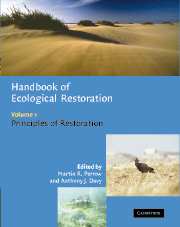Book contents
- Frontmatter
- Contents
- List of contributors
- Foreword
- Preface
- Part 1 The background
- Part 2 Manipulation of the physical environment
- 6 Terrestrial systems
- 7 Wetlands and still waters
- 8 Running water: fluvial geomorphology and river restoration
- Part 3 Manipulation of the chemical environment
- Part 4 Manipulation of the biota
- Part 5 Monitoring and appraisal
- Index
- References
8 - Running water: fluvial geomorphology and river restoration
Published online by Cambridge University Press: 29 December 2009
- Frontmatter
- Contents
- List of contributors
- Foreword
- Preface
- Part 1 The background
- Part 2 Manipulation of the physical environment
- 6 Terrestrial systems
- 7 Wetlands and still waters
- 8 Running water: fluvial geomorphology and river restoration
- Part 3 Manipulation of the chemical environment
- Part 4 Manipulation of the biota
- Part 5 Monitoring and appraisal
- Index
- References
Summary
INTRODUCTION
Perhaps the overwhelming perception from fluvial geomorphologists in much of the developed world is that human modification to the basin sediment system now constitutes a major control on river morphology (Gregory, 1995). The term ‘river training’, once used by civil engineers when required by the modernist agenda to minimise the risk of flooding and erosion, sums up the morphological strictures placed on many (if not most) channels in Europe and North America. In the humid temperate parts of the developed world there has been no part of the channel network safe from ‘channelisation’ to protect human communities and the restoration effort is mainly characterised, as in the UK, by efforts to restore the ‘natural’ morphology directly, via a new kind of engineering works. However, in the semi-arid lands of the developed world, the engineering emphasis has been upon drought protection by dam construction to achieve ‘river regulation’ and it is via the profound changes to the flow regime that ‘damage’ to morphology – and hence physical habitat – has occurred. Logically, it is under an agenda of restoring an environmentally beneficial flow regime (see Downs et al., volume 2) that fisheries managers and ecologists seek geomorphological guidance.
This chapter brings together experiences of restoration via direct morphological intervention (mainly in the UK) and via flow management (mainly in the semi-arid realm of the USA). In both climatic zones a third vital element of the in-stream physical habitat must be considered: the sediment supply from the catchment.
- Type
- Chapter
- Information
- Handbook of Ecological Restoration , pp. 133 - 152Publisher: Cambridge University PressPrint publication year: 2002
References
- 6
- Cited by



